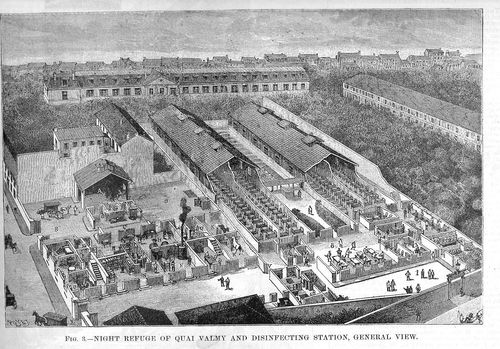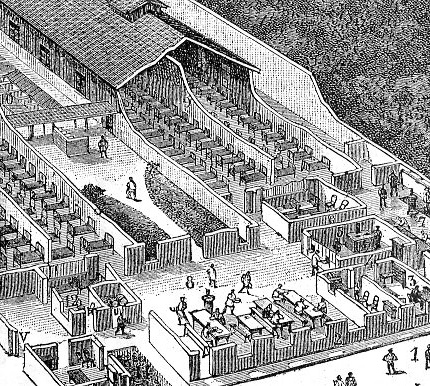JF Ptak Science Books Quick Post
[Source: Scientific American Supplement #842, February 22, 1892]
Browsing through the Columbian year of 1892 in the Scientific American Supplement I came across this interesting social-architectural cross section and story of poor relief (for men) in Paris. It was seen as a great of comfort for men who had none, and model for how men of no means could be accommodated and assisted. The poor refuge at Quai Valmy would be the nighttime home of 200 men for three consecutive nights every two months. They were provided with a bed, clean bedclothing while their own clothing was disinfected and washed, dinner, and a breakfast, and then sent again on their way.
The description of the experience follows (the bold numbers refer to the numbers in the cutaway view):
"After entering the gate which opens at nightfall and crossing court 1 the person seeking shelter awaits his turn to enter in a building 2. Then he enters the passageway that runs along the reception office. Here he must give his name address trade and other information proper for proving his identity such as workman's or soldier's livret and then he goes immediately through the corridor 4 to the bath hall 7 where he divests of of his clothing."
"After leaving this on a bench he must cover all of his body with carbolic soap put at his disposal by the agents who watch all these operations with the greatest care. Then he places himself under an apparatus that showers him with warm water. During this he stands in a tub filled with warm water. The cleaning and showering of all parts the body having been effected the man puts on a shirt a pair of trousers and a vest furnished the establishment. During this time his clothing and linen of all kinds have been carried to the disinfecting station."
"The next morning on rising to leave the refuge the man exchanges these borrowed effects for his own which have been cleaned and disinfected. This done the man passes through the corridor 6 and in front of the wicket of the kitchen 5 receives his portion of food which he goes to the dining hall 8 to eat at the tables arranged therein. For each man the rations are at night a quart of soup of bread and vegetables and in the morning on leaving a piece of bread weighing about ten ounces. As a beverage he receives water to which has been added a little gentian and licorice."
"Thus washed and fed the beneficiary betakes to one of the dormitories 9 where he lies down upon one of the beds arranged in rows of twenty five in large structures heated in winter and aerated in summer. He finds here an iron bedstead provided with a mattress a bolster sheets and a blanket which are kept in a perfect state of cleanliness. The springs of these beds are of a new and interesting arrangement. They are formed of a metallic frame in which is stretched a thick cord rolled several times and forming a sort of lattice work. The elasticity of the system is excellent its cleanliness easily assured and its net cost extremely low. If we add to these various structures the lodge of the keepers 12 the lodge of the superintendent of the water closets 10 which have to be carefully looked after and the storerooms we shall have traversed all the parts of this establishment which are kept perfectly clean and are very carefully managed and are combined with a view to utility rather than to architectural beauty which would be much out of place for here every resource must be employed for rendering the greatest assistance possible to the victims of fate and its net cost extremely low."





Comments